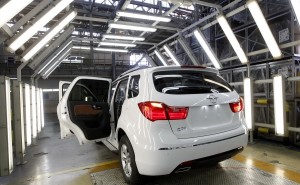June 17, 2016

Iran’s auto industry, which just started emerging from a deep depression in the last Persian year, has headed back into decline since Now Ruz, according to new report from the vehicle manufacturers’ association.
According to Trend News, automakers have not managed to sell more cars as anticipated since the end of sanctions in January. It suggests buyers are tired of the same substandard vehicles being touted by manufacturers maintaining inflated prices.
The output of automakers in the first two months of the current Iranian year fell by 2.8 percent to 158,571 vehicles.
The managing director of the Rakhsh Khodro Diesel Company, Akbar Mirza-Hossaini, said Iran’s automotive industry has entered a recession and auto-makers have not fully benefited from implementation of the Joint Comprehensive Plan of Action, as the nuclear deal is formally titled.
A number of Asian and European automakers at first showed enthusiasm to get into the Iranian car market, Mirza-Hosseini said, but now are pulling back. “There are political reasons behind the reluctant behavior of the international companies,” he said.
Iran’s car output during the last Persian year actually decreased 13.7 percent compared to the previous year, with Iranian companies manufacturing 976,836 cars. After a hot start, sales cooled and the firms failed to break the 1 million mark as anticipated.
Since 2011, the number of car sales has decreased dramatically, falling 53 percent from 1.5 million to 730,000 in 2013, according to Consultancy.uk. The market has picked up only slightly in recent years, averaging 0.9 million between the start of 2014 and the end of 2015.
The slump in the auto market is one key factor in the high unemployment. The auto industry is—or was—a huge employer. While the oil industry is the major generator of revenues in the country, it actually employs relatively few people.
Imports of cars and parts rose 5.5 percent in the first two months of the current Iranian year compared to same period last year. Imports, therefore, cannot be blamed for the 13.7 percent drop in domestic car sales in that same time frame, although many commentators assert that car buyers don’t trust the quality of Iranian cars and are awaiting the arrival of foreign models.
With the import duty on imports standing at 100 percent, only a small portion of the Iranian population can even look at imports. Supreme Leader Ali Khamenehi insists on the high duty to protect domestic production. President Ahmadi-nejad lowered the import duty four years ago, saying he wanted to pressure domestic automakers to improve quality, but Khamenehi immediately overruled him.
Economists and auto industry salesmen say a key factor in the poor sales is the lack of credit available for prospective buyers.
Imports have come from Turkey, Italy, China, South Korea, Taiwan, Japan, France, Belarus, Spain, Macedonia, Kuwait and Belgium, Iranian media reports say.
Iran exported vehicles, components and spare parts to Venezuela, Egypt, Poland, Kuwait, Qatar, Kazakhstan, France, Russia, Iraq, Sudan, Ivory Coast, the Czech Republic and Uzbekistan during the two months. It is not a major factor in any of those markets, however.




















